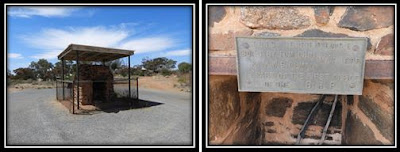 |
| Mining, Ore Tramway and Movie history reflected in the 'Silverton' sign. |
In
1883 the name of the town was proclaimed and a post office was built. The population boomed from 250 up to 3000
within two years. With the growth in population
came the typical list of supporting businesses and services (both necessary and
parasitic) that go hand in hand with mining town development. These included doctors, law (police) and order
(solicitors and judges), power-brokers (local politicians), newspapers, hotels, religion and all
manner of entrepreneurs looking to make a buck in the thriving mining town.
Unfortunately
for Silverton’s longer term growth, in 1885 and just 25km away in Broken Hill, the
discovery of silver, lead and zinc deposits (which subsequently proved to be
the largest in the world) meant that Silverton’s population had already
peaked. People moved to Broken Hill and
the town started to decline just a few short years after being established. With a general shortage of building materials
available in the greater Broken Hill area, many of Silverton’s buildings were
dismantled and transported to Broken Hill and rebuilt there.
While
the miners are long gone a few significant historic buildings still remain,
and just 40 people currently live in Silverton but it appears to have found a
new lease of life. With its clear blue
skies, ‘Outback Red’ landscapes and classic 1800’s stone buildings, the location
has attracted filmmakers from afar. Since
about 1980 the town has hosted dozens of movie and TV productions. These include Mad Max 2, and Priscilla Queen of
the Desert, amongst others.
The
Silverton Hotel seems to feature in just about everything that happens here from
movies through to where a visitor will eat when they are in town.
 |
| At lunchtime there were more people inside than live in the town! |
The
pub attracts everyone and on the day we were here there was more than the town
population inside having lunch. Not bad
for a ghost town!
Of
the 40 residents here, there are a number of artists. In our travels along the Darling River we
came upon the work of Lightning Ridge artist John Murray, who proved to have a
bit of a thing for Emus (remember the sculpture of Stanley the Emu, and other
cartoon like paintings with Emus featuring strongly). In Silverton one of the local artists ‘in
residence’ is Howard Steer who has quite the strong sense of ‘bush humour’ and appears
to have a thing for the Flying Doctor – not the Royal Flying Doctor Service
(RFDS), which he no doubt strongly supports, but a ‘Flying Doctor’ complete
with medical bag and his own pair of wings, that he includes in almost every
painting he does. An example of what I
am talking about can be seen in the photo of a painting that he did on the side
of a broken down old car that is positioned at the entrance to his gallery in
Silverton. The painting is called 'Flying Doctor's New Website'. If you click on the image to enlarge you will see a couple of spider webs in the branches of the trees. That's bush humour for you.
 |
| Flying Doctor's New Website - Painting on car door at entrance to gallery |
For
more examples of his work you can click on the link provided at the bottom of
this blog.
With
that I shall sign off for this episode of WTF? – Where are The Farrows? and
will also conclude this 'Darling River Run' series as we will arrive back home in
the next day or so. I hope you have
enjoyed the posts and that the style of writing has not become boring. Until our next adventure, please take care of
yourselves and the ones you love.





































